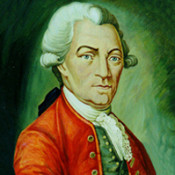
Birthday anniversary of Stepan P. Krasheninnikov, great Russian scholar and explorer of Kamchatka
31 October (11 November) 1711 (or 1713), in Moscow, into a family of soldier was born Stepan Petrovich Krasheninnikov, Russian traveler, explorer of Siberia and Kamchatka, founder of the national ethnography and speleology, the first Russian academician-geographer (1750).
In 1724 Krasheninnikov entered the Moscow Slavic-Greek-Latin Academy. After graduation, he studied in the Petersburg University. In the end of 1732, by a decree of the Senate, among other 12 high school students, he was assigned to the Petersburg Academy of Sciences in order to be trained and join the Second Kamchatka expedition. During a few moths students were given lectures on geography, botany, zoology and other sciences. In 1733, along with five co-students, Krasheninnikov became a member of the Second Kamchatka expedition, attached to the detachment of I. G. Gmelin and G. F. Miller.
In summer of 1735 Krasheninnikov was charged with studying warm springs at the river Onon. Early next year, from Irkutsk, Krasheninnikov set off again for a big trip. He participated in description of the river Lena, went up the river Vitim and to the basin of the river Vilyuy in order to examine salt springs. After each trip the young traveler gave a detailed description of his itinerary in his reports.
4 (15) October 1737 Krasheninnikov, on board of a small vessel “Fortune” headed for Kamchatka via Okhotsk, but on the way to the peninsula the boat ran aground, its passengers and crew found themselves on the shore without their belongings and equipment. Up the river Bolshaya, in dugout boats, Krasheninnikov reached Bolsherechensky stockade town. Joined by few assistants, he began a comprehensive exploration of Kamchatka which lasted till the end of 1740. On Kamchatka, Krasheninnikov described its four eastern peninsulas: Shipunsky, Kronotsky, Kamchatka and Ozernoy, the gulfs formed by them, and also several bays, including the Avacha Bay. He followed the flow of some rivers, first of all Kamchatka River, characterized a series of lakes including Nerpichiye and Kronotskoye lakes.
Krasheninnikov explored almost all the highest stratovolcanos of Kamchatka (Avachinsky, Koryaksky, Kronotsky, Tolbachinsky) and the largest active volcano in Eurasia – Klyuchevskaya Sopka. In spring of 1738, having visited Pauzhetki valley (left tributary of Ozernaya River), he discovered half-meter geysers and described them for the first time. The scholar also studied the history of Kamchatka exploration, wrote about the nature of Kuril and Aleutian Islands, provided some information about the North-Western America; besides geographic data, he also gathered extensive ethnographic, floristic and zoological materials.
Krasheninnikov made a characteristic of the Itelmens living on the Karaginsky Island and wrote down some words of their dialect. Owing to the scholar, the world science enriched with fundamental information on the Itelmens, Koryaks and Ainu people, their history, ethnography, customs, religious beliefs, mythology.
In June of 1741 Krasheninnikov, having completed his explorations of Kamchatka, left the peninsula and returned to Petersburg via Siberia. The Academic Council, having recognized a great knowledge of the young scholar in natural history and taken into account reports on his explorations, resolved to let Krasheninnikov stay assigned to the Academy of Sciences in order to perfect himself in sciences. Two years later he was acknowledged a junior scientific assistant of the Academy.
In April of 1750 Krasheninnikov was given a title of professor of natural history and botanic. Two months later he became the chancellor of the Petersburg University and inspector of the Academic classical school.
For some years Krasheninnikov had been processing the materials of his explorations and composed the manuscript of the “Description of the Kamchatka Land”. At the same time, in 1749-1752, he studied the flora of the former Petersburg Province.
Hard work and constant indigence undermined his health quite early. 25 February (8 March), 1755 Stepan Petrovich Krasheninnikov died.
The “Description of the Kamchatka Land”, the first work about Kamchatka in the Russian and world literature, was issued already after the death of the author. The work of Krasheninnikov was translated into four European languages (German, English, French and Dutch), having become a model for several generations of geographers and ethnographers.
Lit.: Андреев А. И. Жизнь и научные труды С. П. Крашенинникова (с приложением списка его трудов) // Советский север: сб. статей, посвящённый памяти С. П. Крашенинникова к 225-летию со дня рождения. 1939. № 2. С. 5-64; Он же. Ломоносов и Крашенинников // Ломоносов: сб. статей и материалов. М.; Л., 1940. С. 286-296; Виртуальная выставка «Академии наук профессор Степан Петрович Крашенинников» [Электронный ресурс] // Камчатская краевая библиотека. 1999-2016. URL: http://kamlib.ru/library.php?page=res6_krash; С. П. Крашенинников в Сибири. Неопубликованные материалы. М.; Л., 1966; Фрадкин И. Г. С. П. Крашенинников. М., 1974.
Based on the Presidential Library’s materials:
Крашенинников С. П. Описание Земли Камчатки. Т. 1. СПб., 1755;
Крашенинников С. П. Описание Земли Камчатки. Т. 2. СПб., 1755;

